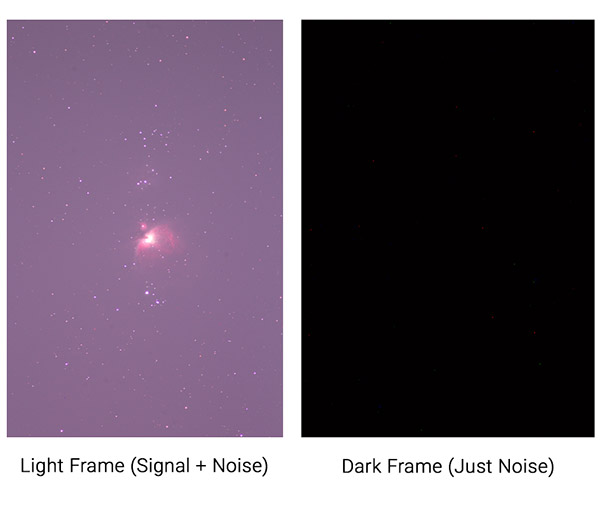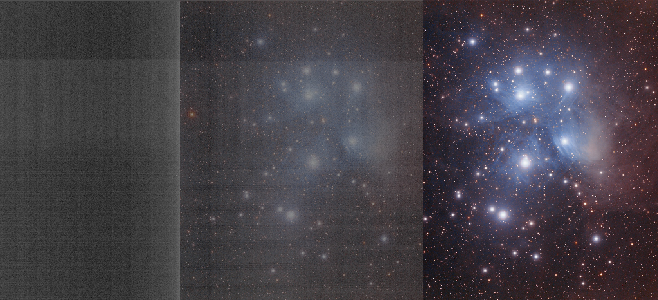How Many Should I Take Of Each. The images shown here were obtained with a number of 40-60 dark frames obtained at the end of each shooting session.

How To Take Dark Frames For Astrophotography Best Practices
Aim to capture 16-30 dark frames for conversion into a single master frame to average out the noise artefacts and increase the signal to noise ratio.

. With full-frame CMOS sensors on reflector telescopes this seems to have removed the vignetting. Because each exposure is less than a second you can quickly accumulate 20-40 bias frames for stacking purposes. But unfortunately I had this donut-like patterns while processing which occurs due to lack of dark frames.
Like many aspects of deep-sky astrophotography your method of taking flat frames will vary depending on the equipment you use. Hi few nights ago I took 12 light frames of 5 min. Its a good idea if you have the time and can take 20 dark frames.
If you have the time and to take 20 dark frames its a good idea. To get the most out of your table aim for at least 15. Thats an hour of exposure.
Only you will now need to match the exposure time the ISOgain value and the temperature of your flat frames. Weve seen this come up numerous times in comments and descriptions of images and in replies so we. These can be easily captured with the lens cap on your camera.
Dark frames primarily are used to subtract out thermal noise accumulation during long-exposure imaging sessions. A more realistic rule of thumbs particularly for taking darks in the field is. Take a few of them about 10 to 20 is usually enough.
With median stacking that should happen very quickly and its hard to see much benefit in going beyond say 9 darks maybe 15. Each CCD or CMOS chip generates a readout noise which is a signal created by the. I believe that dark calibration frames are a must for DSLR astrophotography.
Whether I am using a remote shutter cable on the DSLR or am running a sequence of the image in Astro Photography Tool or BackyardEOS collecting bias calibration frames takes less than 5 minutes. Bias Frames The BiasOffset Frames are used to remove the CCD or CMOS chip readout noise from the light frames. Calibration frames are an important part of the astrophotography process and if you get in any way serious about it they are essential.
Then I took 3 dark frames which is 15 min of exposure and thought Id be fine. In order for the dark frame to do its job there needs to be no light whatsoever entering the camera lens. About the dark frames The suggestion was to take 20 shots at the end of my session.
Download your dark frames from a camera in exactly the same way as your image frames so in addition to holding a. The uneven field illumination and vignetting in my deep sky images were a real pain to correct in post-processing. Flat frames are used to even out uneven illumination and certain other cosmetic defects.
With median stacking you may as well shoot an odd number of frames as at least youll get an actual pixel value returned though in reality it makes very little perhaps no difference. Ill make sure that I cover my eye piece too. Due to the high ISO number used for untracked astrophotography the darkframe noise is usually high.
Now I know that flat frames are as important as taking dark frames. The images need to be the same exposure length ISO and temperature as your light frames. Ideally the more calibration frames you take the better.
The DeepSkyStacker help sections states that using a minimum of 20 frames is ideal and using 50 100 will create nearly noise-free master dark frames. Therefore the number of dark frames should also be high in order to compensate for this. - posted in Beginning Deep Sky Imaging.
If your astrophotography photograph incorporates data from multiple nights youll need to match the darks for each set. A dark frame is like a bias frame in that its an image taken with no light falling on the image sensor but dark frames need to be the same length as your light frames. Capturing around 30 frames of each of the darks flats and biases works well and after processing they are saved as masters for reuse.
Just aim to use at least 15 as a minimum. Capture at least 10 dark frames then create an. In other words if you take several 3-minute exposures on your target youll want to calibrate them using a 3-minute master dark frame which youll subtract from the image.
Select the dark frames you captured from the same imaging session. How many dark frames do you take. This ensures that the dark frame doesnt add any unwanted noise of its own to your images.
Last Updated on February 18 2022 by Practical Astrophotography Staff. This cuts down on processing time as images from large format cameras can take a long time to process in any software. Many Budding Astrophotographers are often confused on exactly what Calibration frames are and if they even need to use them since they do take quite a bit of effort to acquire.
I recommend using a minimum of 15 dark files or more. Just saw you also mentioned taking dark frames at the end of your imaging session Thank you. Since the temperature is important try to shoot dark frames at the end of or during your imaging session.
Today you can capture 15 dark frames for each project with any camera.

How To Take Dark Frames For Astrophotography Best Practices

Guide To Calibration Frames Lights Darks Flats Dark Flats And Bias

How To Take Dark Frames For Astrophotography Best Practices

Re Astrophoto Post Processing Challenge Dark Frames And Noise Astrophotography Talk Forum Forum Digital Photography Review

Dark Frames And Bias Frames Demystified Sky Telescope Sky Telescope

Comparison Of An Image With And Without Dark And Bias Frames R Astrophotography

A Brief Guide To Calibration Frames Bias Dark Flats And Dark Flats Practical Astrophotography Magazine

Dark Frames In Astrophotography What They Are How To Use Them Bbc Sky At Night Magazine
0 comments
Post a Comment